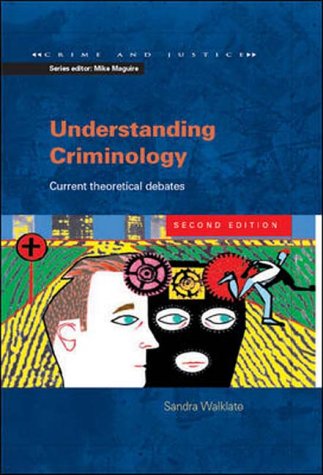

![]()
![]()

This new edition of Understanding Criminology is based on the many changes in the phenomenon of crime that have developed in the last two decades. These changes are inevitable due to ever-changing political, social and economic circumstances. Special emphasis is given to: sociological and critical perspectives on crime; the analysis of the complex relationship between crime and gender, crime and politics, crime and the underclass, the citizen and the state; and victimology, an academic discipline to which Sandra Walklate has made a remarkable contribution (Walklate, 1989; Mawby & Walklate, 1994).
The book consists of eight chapters. Chapter 1 defines the basic terminology, including crime, criminals, criminology and criminal justice. In addition, it discusses three main sources of crime measurement, namely official statistics, criminal victimization surveys and self-report studies, and the strengths and limitations of each source. Chapter 2 examines a wide range of criminological perspectives, namely classical criminology, positivist criminology, social disorganization, strain theory, labeling theory, Marxist criminology, radical criminology and critical criminology. In the author's words, this chapter intends 'to identify in a little more detail some of the key themes embedded in earlier criminological debate' which in turn 'informs present debates' (p. 15). It summarizes the key features of these theories, although readers have to consult the suggested further reading for more details.
Chapters 3 and 4 discuss the emergence of realism within criminology in the British context. While Chapter 3 focuses on the right-wing thinking about crime, Chapter 4 considers the origin of left realism as a means of reflecting the reality of crime and discusses the relationship between left realism and New Labour. In Chapter 3, it is suggested that 'right realist' thinking which emphasizes individual responsibility for criminal conduct and the failure of liberal criminal justice policy has become dominant since the 1980s. Various 'right realist' thinking (including socio-biological explanations, rational choice theory, routine activity approach and administrative criminology) are elaborated in detail. One common theme of right realism is that crime, responsibility of individual citizens and family are all inter-related, marking the resurgence of interest in conservative criminology. Conversely, Chapter 4 is concerned with left realism, or radical realism, as an alternative way of understanding the crime problem in England in the 1980s. Left realists such as Jock Young argue for the importance of multi-agency intervention and the development of an inclusive society, characterized by security and tolerance to tackling the reality of crime.
Chapters 5 to 7 deal with other explanations of crime, exclusively relying on British literature. Chapter 5 addresses how gender issues have been hidden or even neglected within mainstream (or malestream) criminology, thereby limiting our understanding of female offending. Four strands of feminist thought (namely, liberal feminism, radical feminism, socialist feminism and post-modern feminism) are described, and their impacts on criminology are illustrated with examples. However, omissions of other schools of thought such as Marxist feminism and Existential feminism should have been acknowledged. In line with feminist researchers, Sandra Walklate asserts that a gendered lens is useful in analyzing the differences in terms of the offending behaviour and experience of criminal justice system between males and females. Chapter 6 examines the interconnections between criminology, criminal justice, social justice and politics. It is indeed a stimulating chapter guiding readers to think how the changing conception of the welfare state and changing nature of family structures may facilitate an understanding of the criminalization process. Three major victimological thoughts, namely positivistic victimology, radical victimology and critical victimology are introduced in Chapter 7. These are followed by an analysis of how they inform current victim policy and practice, such as the re-orientation of the probation service in supporting victims and the development of restorative justice programmes in dealing with young offenders.
The concluding chapter summarizes the discussion in the preceding chapters and points to some newer ways of understanding how crime has been constructed. Theoretical concerns such as gender, race and class, risk, trust, and social capital are found useful in informing the future development of criminology. Overall, this book is essential reading for students who wish to acquire a good understanding of criminological theory. However, even good textbooks can be improved, and have a natural lifespan. New data, new ideas, and new policies should be updated in the revised edition in future.
Wing Hong Chui
City University of Hong Kong
WALKLATE,S. (1989) Victimology: The Victim and the Criminal Justice System, London: Unwin Hyman.